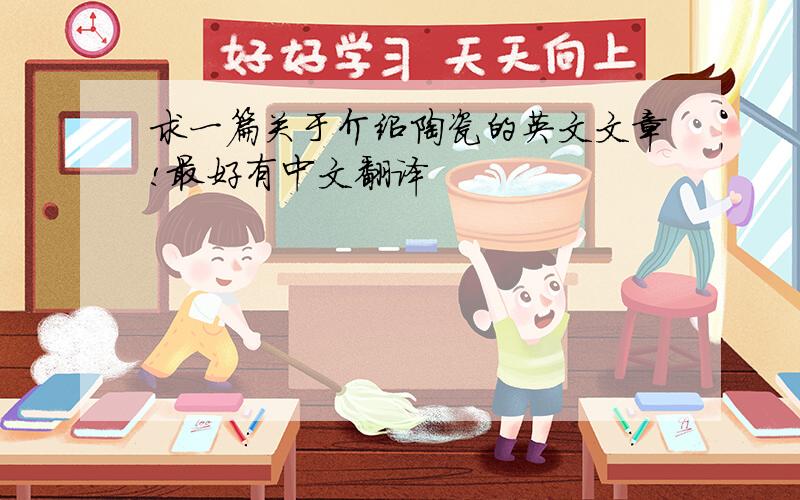求一篇关于介绍陶瓷的英文文章!最好有中文翻译
来源:学生作业帮助网 编辑:作业帮 时间:2024/04/30 05:10:24

求一篇关于介绍陶瓷的英文文章!最好有中文翻译
求一篇关于介绍陶瓷的英文文章!
最好有中文翻译
求一篇关于介绍陶瓷的英文文章!最好有中文翻译
"陶瓷"是一种通称,"陶"和"瓷"在质地上、物理性能上有很大区别.中国是最早制造陶器的国家之一,是最早发明瓷器的国家.
陶器的出现大约在距今1万年左右,中国进入新石器时代,开始了定居生活,盛水、蓄物等日常生活的需要,促使了陶器的发明.中国陶器的分布比较广泛,主要集中的在黄河流域和长江流域.其中仰韶文化是新石器时期比较有代表性的文化类型,以彩陶为特点,也称"彩陶文化",它派生出半坡和庙底沟两个类型,装饰图案有很高的艺术价值.马家窑文化是新石器晚期的文化类型,比仰韶文化略晚,距今约5000年.黑陶是继彩陶之后的又一伟大创造发明,距今约4000年的龙山文化时期,出现了工艺独特的蛋壳陶.近些年来,山东、河北一带多有仿制,有较高的收藏价值.秦汉时期的陶俑,是我国古代人物雕塑的高峰,使制陶技术和艺术达到了很高的境地.此外,唐代的三彩器、明清两代的紫砂器等,都是中国陶器文物的重要内容,很值得深入收藏和研究.
陶瓷(Ceramics),陶器和瓷器的总称.陶瓷的传统概念是指所有以粘土等无机非金属矿物为原料的人工工业产品.它包括由粘土或含有粘土的混合物经混炼,成形,煅烧而制成的各种制品.由最粗糙的土器到最精细的精陶和瓷器都属于它的范围.对于它的主要原料是取之于自然界的硅酸盐矿物(如粘土、长石、石英等),因此与玻璃、水泥、搪瓷、耐火材料等工业,同属于"硅酸盐工业"(Silicate Industry)的范畴.
陶瓷的发展史是中华文明史的一个重要的组成部分,中国作为四大文明古国之一,为人类社会的进步和发展做出了卓越的贡献,其中陶瓷的发明和发展更具有独特的意义,中国历史上各朝各代不同艺术风格和不同技术特点.英文中的"china"既有中国的意思,又有陶瓷的意思,清楚地表明了中国就是"陶瓷的故乡".changaiyin
早在欧洲人掌握瓷器制造技术一千多年前,中国人就已经制造出很精美的陶瓷器.中国是世界上最早应用陶器的国家之一,而中国瓷器因其极高的实用性和艺术性而备受世人的推崇.
所谓陶器和瓷器是指用可塑性制瓷粘土和瓷石矿做胎体,用长石和石英等原料制釉,并且通过成型、干燥、烧制而成的制品,主要有日用、艺术、和建筑陶器等三种.考古发现已经证明中国人早在新石器时代(约公元前8000)就发明了陶器.原始社会晚期出现的农业生产使中国人的祖先过上了比较固定的生活,客观上对陶器有了需求.人们为了提高生活的方便,提高生活质量,逐渐通过烧制粘土烧制出了陶器.
随着近代科学技术的发展,近百年来又出现了许多新的陶瓷品种.它们不再使用或很少使用粘土、长石、石英等传统陶瓷原料,而是使用其他特殊原料,甚至扩大到非硅酸盐,非氧化物的范围,并且出现了许多新的工艺.美国和欧洲一些国家的文献已将"Ceramic"一词理解为各种无机非金属固体材料的通称.因此陶瓷的含义实际上已远远超越过去狭窄的传统观念了.
迄今为止,陶瓷器的界说似可概括地作如下描述:陶瓷是用铝硅酸盐矿物或某些氧化物等为主要原料,依照人的意图通过特定的物理化学工艺在高温下以一定的温度和气氛制成的具有一定型式的工艺岩石.表面可施釉或不施釉,若干瓷质还具有不同程度的半透明度,通体是由一种或多种晶体或与无定形胶结物及气孔或与熟料包裹体等微观结构组成.
陶瓷工业是硅酸盐工业的主要分支之一,属于无机化学工业范围.但现代科学高度综合,互相渗透,从整个陶瓷工业制造工艺的内容来分析,它的错综复杂与牵涉之广,显然不是仅用无机化学的理论所能概括的.
陶瓷制品的品种繁多,它们之间的化学成分.矿物组成,物理性质,以及制造方法,常常互相接近交错,无明显的界限,而在应用上却有很大的区别.因此很难硬性地归纳为几个系统,详细的分类法各家说法不一,到现在国际上还没有一个统一的分类方法.
"Ceramic" is a generic term, "Tao" and "Porcelain" in texture, the physical properties there are very different. China was among the first to create one of the countries of pottery, porcelain was one of the first invention.
The emergence of pottery dating back about 1 million years or so, China has entered the New Stone Age, began to settle in life, water, with objects of daily life, such as the need to promote the invention of pottery. Chinese pottery wider distribution, mainly in the Yangtze River and Yellow River Basin. Yangshao culture which is the New Stone Age culture more representative of the type, characterized by painted pottery, also known as the "painted pottery culture", which derived Banpo and Miao Digou two types of decorative patterns, has high artistic value. Majiayao culture is the culture of the late New Stone Age type than a little late Yangshao culture, since about 5000. Black painted pottery is the second after another great invention, since about 4000 the Longshan Culture period, there has been a unique process of eggshell pottery. In recent years, Shandong, Hebei and more in the vicinity of imitation, there is a high value for collection. Qin and Han Dynasty pottery figurine of China's ancient sculpture of the peak figure, so that the ceramic technology and the arts reached a high position. In addition, three of the color of the Tang Dynasty, the Ming and Qing dynasties such as Yixing, China is an important aspect of pottery relics, it is worthy of collection and research.
Ceramics (Ceramics), the general term for pottery and porcelain. Ceramic refers to the traditional concept of all inorganic non-metallic minerals such as clay as raw material of artificial industrial products. It consists of clay from or containing a mixture of clay by kneading, molding, and calcined made of a variety of products. By the most rough-earth to the most refined of the fine pottery and porcelain are it. For its main raw materials are derived from natural silicate minerals (such as clay, feldspar, quartz, etc.), and glass, cement, ceramic, refractory material, such as industry, with an "industrial silicate" (Silicate Industry ) Area.
The history of ceramics is the history of Chinese civilization is an important part of China, as one of the four ancient civilizations, human development and social progress made outstanding contributions, including the invention of ceramics and the development of a more unique significance , The history of China-North Korea on behalf of all the different artistic styles and different technical characteristics. English of "china" China not only mean, ceramics and mean, clearly demonstrates China is the "hometown of pottery." changaiyin
As early as the Europeans have porcelain manufacturing technology over 1000 years ago, Chinese people have created a very fine ceramics. China is the world's first application of one of the countries pottery, and porcelain from China for its high artistic quality and relevance of the world have attracted much praise.
The so-called pottery and porcelain refers to the use of plastic ware and porcelain clay quarry to do matrix, quartz and feldspar, and other raw materials-glaze, and through the forming, drying, firing from the products, mainly for daily use, art, and architecture Three pottery. Archaeological discoveries have proved that the Chinese people as early as the Neolithic Age (about 8000 BC) invented pottery. The emergence of primitive society with advanced agricultural production so that the ancestors of the Chinese people lead a life of a relatively fixed, the objective of pottery with the demand. In order to improve people's lives easier, improve the quality of life, gradually burn through the burning out of the clay pottery.
With the development of modern science and technology, and the past 100 years there have been many new varieties of ceramics. They no longer use or the use of small clay, feldspar, quartz and other traditional ceramic materials, but the use of other special materials, and even extended to non-silicate, non-oxide scope, and there have been a lot of new technology. The United States and some European countries have literature "Ceramic" understanding of the term for a variety of solid inorganic non-metallic materials known. Therefore, the meaning of ceramics in fact go far beyond the traditional concept in the past the narrow.
To date, the Definition of ceramics may be generally described as follows: The ceramic is aluminum silicate minerals such as oxides or as the main raw material, in accordance with the intention of people through specific physical and chemical processes at a high temperature to a certain degree of Temperature and atmosphere made of a certain type of rock technology. Glazing may be on the surface or glazing, porcelain has a number of different levels of transparency and a half, the species by one or more of the crystal and amorphous or cement and clinker with pores or inclusions, such as micro-structure.
Portland ceramic industry is one of the main branches of industry, belong to the scope of inorganic chemical industry. However, modern science and highly integrated with each other to infiltrate from the ceramic industry as a whole manufacturing process to analyze the contents of its complex and involve wide, is not only Using the theory of inorganic chemistry can be summarized.
A wide variety of ceramic products, their chemical composition. Mineral composition, physical properties, as well as manufacturing methods, often close to each other staggered, no boundaries, and in the application there is a huge difference. Therefore, it is difficult to be summed up in a few hard and fast system, a detailed classification of the various different view, the international community to now there is no uniform classification.